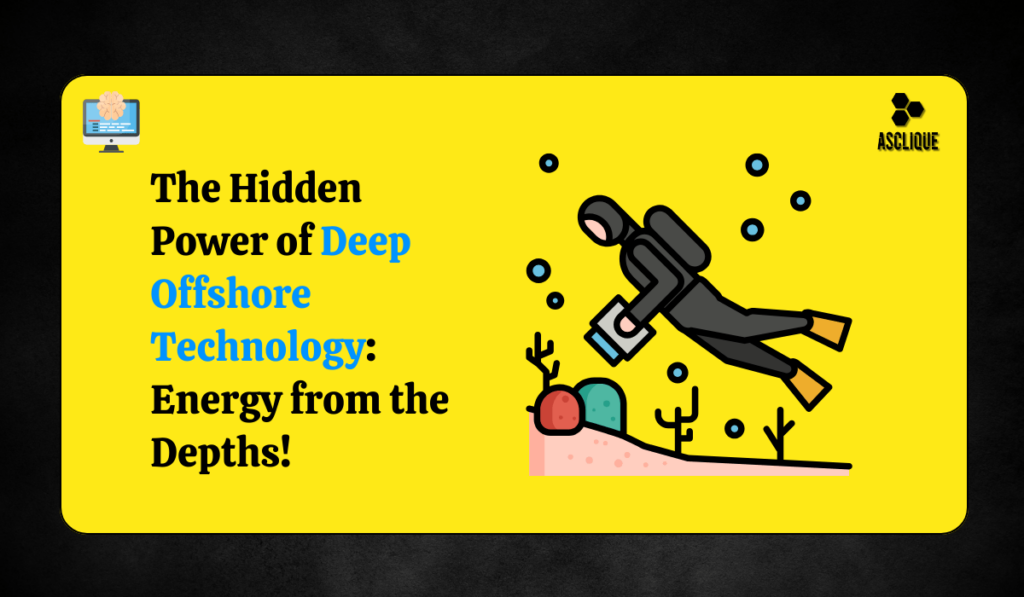Deep offshore technology is one of the most dynamic fields of engineering and innovation. Just a few decades ago, deep offshore was just a niche area of engineering, whereas today it holds the future and has transformed much of the offshore technology into mainstream engineering. More and more deep offshore regions have been found because of the ever-increasing energy demand and declining shallow water reserves. The authors of this paper will discuss marvels, applications, benefits, challenges, and future trends about deep offshore technology.
What is Deep Offshore Technology?
Deep offshore technology is the sophisticated equipment, techniques, and technologies involved in accessing resources that lie in depths deeper than 500 meters in the oceans, such as the extraction and production of resources using all types of oil and gas to renewable sources of energy such as wind farms. Cutting-edge innovations in engineering, robotics, and environmental science are a must for this demanding operating environment.
Major Components of Deep Offshore Technology
Offshore Platforms
Deep ocean resource extraction significantly relies on such structures. Extremes like weather, sea currents, and pressure must, therefore, not affect such structure.
- Fixed: Used in waters not very deep, fixed stands on the bed of the ocean.
- Floating Platforms: Semi submersibles are also popular FPSOs, more for deep ultra-deep areas.
Subsea Systems
Deep offshore operations have a backbone of subsea technology, which is essentially equipment and infrastructure on the seabed.
- Subsea Trees: Seabed structures that regulate the flow of oil and gas from wells.
- Manifolds: Connections of many wells to a single pipeline.
- Pipelines and Umbilicals: Transportation of resources with power and communication to underwater systems.
Remotely Operated Vehicles
ROVs are the robotic systems designed to conduct operations in places too dangerous or inaccessible for humans. The versatile machines inspect pipelines, repair equipment, and survey underwater terrain.
Drilling Technologies
Deep offshore environments facilitate the resources-extracting jobs with super accurate techniques in drilling.
- Directional Drilling: Allows drilling at angles that increase the access efficiency to add more reserves.
- Managed Pressure Drilling (MPD): Controls pressure in the wells to avoid blowouts and to increase safety.
Renewable Energy Solutions
Deep offshore technology is not solely reserved for fossil fuels. Deployments of floating wind turbines and wave energy converters can now be expected in deepsea locations to obtain renewable energy sources.
Applications of Deep Offshore Technology
Deep offshore technology is a technological transformation that performs across all markets, enabling operational activities in environments that are known to be tough on Earth. Here are their primary applications:
The Oil and Gas Industry
The upstream oil and gas industry is heavy on deep-offshore technology by tapping into still-untapped reserves found in ultra-deep waters. Advance systems enable an extraction of sources from areas of:
- Brazil’s Pre-Salt Basins: Vast oil reserves are hidden beneath thick layers of salt and rock.
- Gulf of Mexico: Only advanced technologies may access ultra-deep oil and gas fields.
These means supply much-needed energy resources for the rest of the world to provide for energy needs.
Renewable Energy Projects
Deep offshore technology is opening up renewable energy options such as:
- Float wind turbines. Developed in Europe, they collect wind energy in deep waters.
- Wave energy converters. They use ocean waves as a resource to supplement renewable energies.
These technologies highly contribute to the reduction of carbon emissions and achieving renewable energy targets.
Marine Research
Deep offshore technology is used by scientists to research and protect the ecosystem of the ocean. The most prominent applications are as follows:
- Underwater geology mapping for tectonic studies.
- Marine biodiversity monitoring to understand ecosystem health.
- Investigating the impact of climate change on deep-sea environments.
These applications highlight the flexibility and crucial relevance of deep offshore technology in enhancing energy production, sustainability, and scientific discovery.
Advantages of Deep Offshore Technology
Deep offshore technology boasts many benefits, which make it an important cornerstone in modern energy exploration:
Accessible Resources:
Deep sea reserves are, in most cases, much larger and less depleted than onshore fields. This provides vital sources of energy meeting increased demand in the world.
Technological Advancements:
Deep offshore operations are on the same trend of innovation in robotics, artificial intelligence, and materials science that has transformed this industry. All these fields improve efficiency and take various industries to a different level.
Energy Security:
Deep offshore reserves are crucial to most countries since they reduce reliance on imported energy sources, and energy supply will be more stable and independent.
Economic Impact
Offshore projects generate tens of thousands of jobs in engineering, construction, operations, and maintenance. Offshore projects also spur local economies and foster global cooperation on massive projects.
Through the discovery of new reserves and technological advancements, deep offshore technology is helping to forge a sustainable and economically resilient future for energy.
Challenges of Deep Offshore Technology
Deep offshore technology holds a lot of promise, but it also poses many challenges:
Environmental Issues:
Deep sea drilling can interfere with the marine ecosystem, which can have an impact on biodiversity and ocean health. The danger of oil spills is highly alarming because it can cause long-term damage to aquatic life and coastal regions.
Technical Complexity:
The extreme depth at which the operation takes place requires very advanced technology that can withstand the high pressures, freezing temperatures, and unpredictable underwater conditions. Such systems require a lot of expertise and innovation in design and maintenance.
High Costs
Deep offshore is capital-intensive and the costs often go into billions. Maintenance and upgrades add to the financial burden, making such projects accessible only to well-funded entities.
Safety Risks:
Workers are exposed to a variety of hazards, which include explosions, breakdowns of equipment, and severe weather conditions. Safety on offshore platforms requires constant effort through strict protocols and advanced monitoring.
However, risks are still ongoing, and technological advancements continue with the goal of making deep offshore technology more sustainable and efficient.
Innovations Driving Deep Offshore Technology
AI and Machine Learning:
- AI-based systems have improved decision-making, predictive maintenance, and resource optimization.
Advanced Materials:
- New materials, carbon composites, and high-strength alloys provide durability and corrosion resistance.
Automation and Robotics:
- AUVs and drones reduce the requirement of human intervention in dangerous environments.
Digital Twins:
- Virtual models of offshore systems are used to replicate operations, detect inefficiencies, and test solutions in a danger-free space.
Future of Deep Offshore Technology
The future of deep offshore technology is indeed promising and revolutionary. The key trends include:
Integration with Renewable Energy:
- Deepwater wind farms and hybrid energy systems integrating oil, gas, and renewables will surge.
Sustainable Practices:
- The works to reduce the environmental impact of offshore activities are underway. This includes carbon capture and storage (CCS).
International Collaboration:
- Global collaborations have led to innovations, resource sharing, and working together to face the challenges.
Conclusion
Deep offshore is in the heart of innovative engineering and something at the very epicentre that is responding to some of the world’s critical energy challenges with solutions. From ultra-deep water extractive oil and gas to a source of off-shore power through wind strength, this field is really demonstrating innovation resilience and ambition combined.
FAQs
What is deep offshore technology?
What is the use of deep offshore technology?
It is used widely in oil and gas exploration, renewable energy projects like offshore wind farms, and in marine research studies of biodiversity, underwater geology, and impacts of climate change.
Why is deep offshore technology expensive?
The reason for this high cost is the need for advanced equipment, robust infrastructure, and specialized expertise to be used in extreme deep-sea conditions such as high pressure and low temperatures.
Environmental impacts of deep offshore technology.
Deep-sea operations may interfere with marine ecosystems. Oil spills result from accidents and significantly impact ocean biodiversity and coastal areas.

